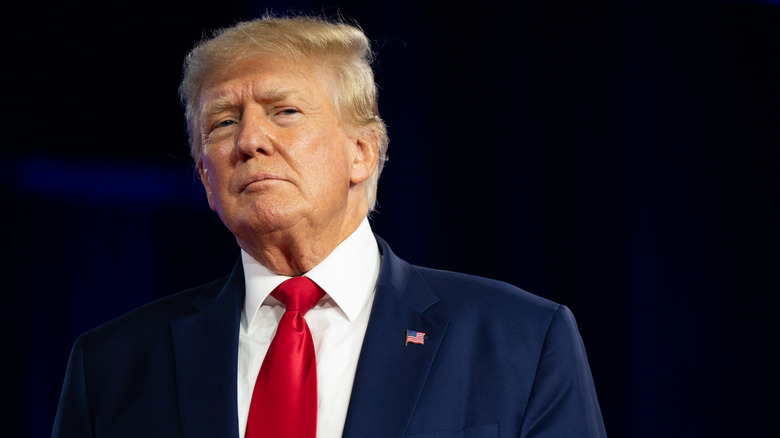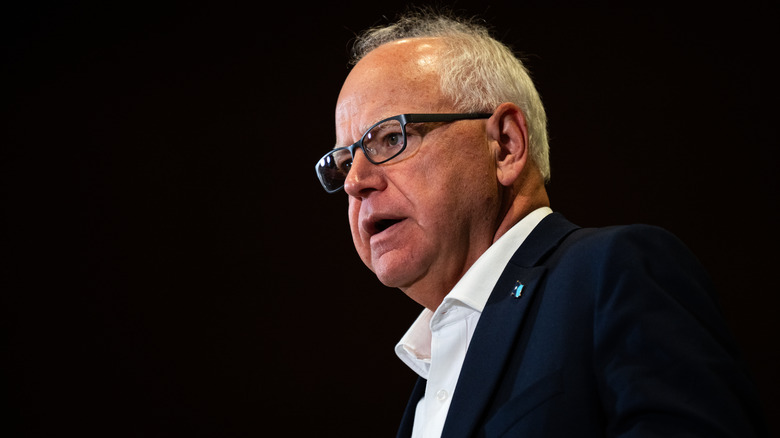Trump's Wild Take On Past Interaction With Tim Walz Proves His Ego Is Always First Priority
On August 6, Kamala Harris announced that Minnesota Governor Tim Walz will be her running mate in the 2024 presidential election. A day later, Republican presidential nominee Donald Trump weighed in on her choice with excitement, telling Fox News, "I could not be more thrilled." However, Trump's glee for Harris' VP pick may have more to do with him seeing Walz as an easy opponent rather than a worthy one. According to CBS News, Trump asserted in an email that "Walz would be the worst VP in history." Despite his distain for Walz, Trump has also taken advantage of the situation to showcase his own past heroics.
In what he characterized as his single interaction with Walz, Trump detailed a protest that occurred during his presidency. "I helped him very much during the riots because his house was surrounded by people that were waving an American flag," Trump explained to Fox News. He went on to claim that Walz contacted him for help, requesting a character reference to diffuse the protestors. "I said, he's a good person," Trump asserted. "They took the American flags and their MAGA flags and they left. It was thousands of people."
Although Trump didn't specify the exact timeframe, he's likely referring to an April 2020 incident outside the Minnesota Governor's Mansion. Unhappy about Walz's restrictions during the early days of the COVID-19 pandemic, the crowd was indeed waving flags, including some with Trump's picture. However, they numbered in the hundreds, not thousands. In addition, while Trump saw himself as the problem solver, Walz had a decidedly different view.
Walz accused Trump of catalyzing protestors
Tim Walz claims Donald Trump's actions contributed to the incident. While the protest had been planned for days, Trump may have fanned the flames by writing on X, (formerly Twitter), "Liberate Minnesota!" Walz told Politico, "It brought armed people to my house."
Journalist Patrick Kessler live-tweeted the incident, stating that Walz reached out to Trump. He wrote: "Walz says the White House should tell him what Minnesota is doing differently or wrong: 'That will take longer than a two word tweet, but I think there's a responsibility to tell us that.'" Walz told Politico that he didn't receive a satisfactory response from Trump: "I asked for clarification. I never got it. I said 'What does 'Liberate Minnesota' mean?'" While Trump remembered just one interaction with Walz, Walz recalled speaking to him multiple times throughout his presidency. While he said Trump hadn't been especially helpful during the pandemic protest, he did recount the president supporting him later that year. "He made public statements, during the unrest with George Floyd, that 'Gov. Walz knows how to do this, he'd been in the military,'" he said.
Trump's story involving Walz isn't the first time ego has informed his campaign style. Whether its deciding the location for a rally in a place he's unlikely to win, speaking out after the assassination attempt on him, or as a motivator for running for re-election in the first place, Trump's self-image has often been a deciding factor. In 2013, Trump made a point of extolling the importance of one's sense of self. "Show me someone without an ego, and I'll show you a loser — having a healthy ego, or high opinion of yourself, is a real positive in life!" he proclaimed on Facebook.

